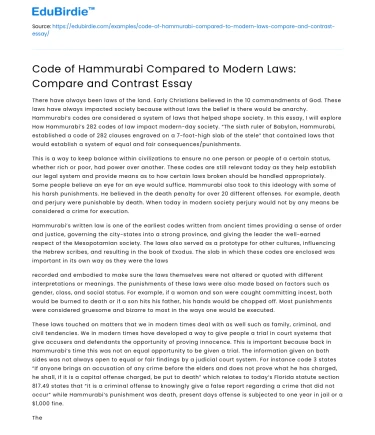There have always been laws of the land. Early Christians believed in the 10 commandments of God. These laws have always impacted society because without laws the belief is there would be anarchy. Hammurabi’s codes are considered a system of laws that helped shape society. In this essay, I will explore How Hammurabi’s 282 codes of law impact modern-day society. “The sixth ruler of Babylon, Hammurabi, established a code of 282 clauses engraved on a 7-foot-high slab of the stele” that contained laws that would establish a system of equal and fair consequences/punishments.
This is a way to keep balance within civilizations to ensure no one person or people of a certain status, whether rich or poor, had power over another. These codes are still relevant today as they help establish our legal system and provide means as to how certain laws broken should be handled appropriately. Some people believe an eye for an eye would suffice. Hammurabi also took to this ideology with some of his harsh punishments. He believed in the death penalty for over 20 different offenses. For example, death and perjury were punishable by death. When today in modern society perjury would not by any means be considered a crime for execution.
Save your time!
We can take care of your essay
- Proper editing and formatting
- Free revision, title page, and bibliography
- Flexible prices and money-back guarantee
Hammurabi’s written law is one of the earliest codes written from ancient times providing a sense of order and justice, governing the city-states into a strong province, and giving the leader the well-earned respect of the Mesopotamian society. The laws also served as a prototype for other cultures, influencing the Hebrew scribes, and resulting in the book of Exodus. The slab in which these codes are enclosed was important in its own way as they were the laws
recorded and embodied to make sure the laws themselves were not altered or quoted with different interpretations or meanings. The punishments of these laws were also made based on factors such as gender, class, and social status. For example, if a woman and son were caught committing incest, both would be burned to death or if a son hits his father, his hands would be chopped off. Most punishments were considered gruesome and bizarre to most in the ways one would be executed.
These laws touched on matters that we in modern times deal with as well such as family, criminal, and civil tendencies. We in modern times have developed a way to give people a trial in court systems that give accusers and defendants the opportunity of proving innocence. This is important because back in Hammurabi’s time this was not an equal opportunity to be given a trial. The information given on both sides was not always open to equal or fair findings by a judicial court system. For instance code 3 states “If anyone brings an accusation of any crime before the elders and does not prove what he has charged, he shall, if it is a capital offense charged, be put to death” which relates to today’s Florida statute section 817.49 states that “it is a criminal offense to knowingly give a false report regarding a crime that did not occur” while Hammurabi’s punishment was death, present days offense is subjected to one year in jail or a $1,000 fine.
The reason this work is so important is that Hammurabi took initiative to calm the anger of civilization. He cared about the well-being of the surrounding empire and created such harsh punishments to prove how serious and concerned he was if one did not follow. The city-states had territories that needed leadership and political unification. Without these laws, citizens would fall into the power of unstable decisions of the current emperor, leading to unjust implications. Humans were not considered equals under Babylonian law, wealth and social status determined their importance. With Hammurabi’s law, there was a general understanding of moral values one would express. Women were finally acknowledged and felt protected by certain childbearing and housekeeping laws. Hammurabi was perceived as a great ruler of his time because he administered justice, and laws were taught fair. Instead of it being spoken word, he wrote it so it would not be altered even the slightest. He also believed that his laws descended from the later known as the God of Justice Shamash, pictured in the sculpture. This creation led to life for generations as others recognized and followed somewhat of the same concepts.
Works Cited
Books:
- Gloria K. Fiero, 2017. Landmarks In Humanities. Fourth Edition.
- McGraw-Hill Education, 2 Penn Plaza, New York, NY 10121 (Fiero, 2017, p# 11-14)
Websites:
- Hussein & Weber,2019, Definition of False Report of a Crime, retrieved from:
- https://www.husseinandwebber.com/crimes/public-order-obstruction/false-report- of-a- crime/ (Hussein and Weber, 2019)
- Ushistory.org, 2019, Hammurabi’s Code: An Eye for an Eye, retrieved from:
- https://www.ushistory.org/civ/4c.asp (Ushistory.org, 2019)






 Stuck on your essay?
Stuck on your essay?

